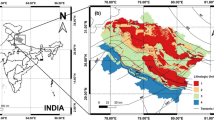Abstract
Empirical, theoretical or hybrid methods can be used for the vulnerability analysis of structures to evaluate the seismic damage data and to obtain probability damage matrices. The information on observed structural damage after earthquakes has critical importance to drive empirical vulnerability methods. The purpose of this paper is to evaluate the damage distributions based on the data observed in Erzincan-1992, Dinar-1995 and Kocaeli-1999 earthquakes in Turkey utilizing two probability models—Modified Binomial Distribution (MBiD) and Modified Beta Distribution (MBeD). Based on these analyses, it was possible (a) to compare the advantages and limitations of the two probability models with respect to their capabilities in modelling the observed damage distributions; (b) to evaluate the damage assessment for reinforced concrete and masonry buildings in Turkey based on these models; (c) to model the damage distribution of different sub-groups such as buildings with different number of storeys or soil conditions according to the both models. The results indicate that (a) MBeD is more suitable than the MBiD to model the observed damage data for both reinforced concrete and masonry buildings in Turkey; (b) the sub-groups with lower number of stories are located in the lower intensity levels, while the sub-groups with higher number of stories depending on local site condition are concentrated in the higher intensity levels, thus site conditions should also be considered in the assessment of the intensity levels; (c) the detailed local models decrease the uncertainties of loss estimation since the damage distribution of sub-groups can be more accurately modelled compared to the general damage distribution models.
Similar content being viewed by others
References
Akbar S (1989) Urban housing in seismic areas: a computerised methodology for evaluating planning strategies for risk mitigation. PhD Dissertation, University of Cambridge, United Kingdom, 216 p
Akkaş N, Erdik M (1984) Consideration on Assessment of Earthquake Resistance of Existing Buildings. Int J Housing Sci 8:49–66
Ansal A, İyisan R, Güllü H (2001) Microtremor measurements for the microzonation of Dinar. Pure and Applied Geophysics 158:2525–2541
Ansal A, Lav A (1995) Geotechnical Factors in 1992 Erzincan Earthquake. Proc. 5th Int. Conference on Seismic Zonation, Nice 1:667–674
Ansal A, Şengezer BS, İyisan R, Gençoğlu S (1993) The Damage distribution in March 13, 1992 earthquake and effects of geotechnical factors. In: Seco e Pinto P (ed), Soil dynamics and geotechnical earthquake engineering. Balkema, Rotterdam, pp 413–434
Applied Technology Council (ATC) (1985) Earthquake damage evaluation data for California, ATC-13 Report. Redwood City, California, 492 p
Asilhan M, Şahin M, Turan E, Kılıç H (2000) Geological and geotechnical investigation report for the revision of the Adapazarı Urban Plan, Adapazarı Metropolitan Municipality, Planning Directorate, February, 36 p
Barbat AH, Moya FY, Canas JA (1996) Damage scenarios simulation for seismic risk assessment in urban zones. Earthquake Spectra 12(3):371–394
Braga F, Dolce M, Liberatore D (1982) A statistical study on damaged buildings and ensuing review of the MSK-76 scale in Southern Italy Nov 23, 1980 Earthquake, Chapter 5, Geodynamics Project, CNR Publ. 503, Rome
Bray JD, Sancio RB, Durgunoğlu HT, Önalp A, Seed RB, Stewart JP, Youd TL, Baturay MB, Çetin KÖ, Christensen C, Karadayılar T, Emrem C (2001) Ground failure in Adapazarı, Turkey, Lessons learned from recent strong earthquakes, Earthquake Geotechnical Engineering Satellite Conference, XVth Int. Conf. on Soil Mechanics and Geotechnical Engineering, Istanbul, pp 19–28
Charles C, Thiel CC, Boissonnade AC (1996) Divergence Between Estimated Building Vulnerability and Observed Damage: A Fuzzy Set Theory Reconciliation, ATC-20-3, Case Studies in Rapid Post earthquake Safety Evaluation of Buildings, Applied Technology Council, California, pp. 115–129
Coburn AW (1987) The use of intensity in earthquake vulnerability assessment, Appendix to Report to the European Association of Earthquake Engineering by Working Group 3, Vulnerability and Risk Analysis, Proc. of 9th European Conference on Earthquake Engineering, Moscow, USSR, 1990
Coburn A, Spence R (2002) Earthquake protection. John Wiley & Sons, West Sussex
Erdik M (1994) Developing a comprehensive earthquake disaster master plan for Istanbul, Issues in urban earthquake risk. Kluwer Academic Publishers, Dordrecht/ Netherlands, pp 125–166
Finn L (1994) Geotechnical aspects of the estimation and mitigation of earthquake risk, issues in urban earthquake risk. Kluwer Academic Publishers, Dordrecht/ Netherlands, pp 35–77
Grünthal G (ed) (1998) European macroseismic scale 1998, European Seismological Commission. Council of Europe, Luxembourg
Kappos AJ, Stylianidis KC, Pitilakis K (1998) Development of seismic risk scenarios based on a hybrid method of vulnerability assessment, natural hazards. Kluwer Academic Publishers, pp 177–192
Kircher CA, Nassar AA, Kustu O, Holmes WT (1997) Development of building damage functions for earthquake loss estimation. Earthquake Spectra 13(4):663–682
Rojahn C (1994) Estimation of earthquake damage to buildings and other structures in large urban areas, issues in urban earthquake risk. Kluwer Academic Publishers, Dordrecht/Netherlands, pp 79–95
Singhal A, Kiremidjian AS (1996) Method for probabilistic evaluation of seismic structural damage. J Struct Eng 122(12):1458–1468
Şengezer B (1999) Damage analysis of Erzincan earthquake, March 13, 1992 and the problem of earthquake in Turkey. Yıldız Technical University, Istanbul, 412 p
Şengezer B (1992) Investigation of seismic risk in urban areas in Turkey and development of disaster mitigation policies. PhD Dissertation, Yıldız Technical University, p 278
Spence R (2000) Recent earthquake damage in europe and implications for loss estimation methodologies, implications of recent earthquakes on seismic risk, Proc. of Japan–UK Seismic Risk Forum 3rd Workshop. Imperial College Press, London, UK, pp 77–89
Thiel CC, Zsutty TC (1987) Earthquake characteristics and damage statistics. Earthquake Spectra 13(4):747–792
UNDRO (1978) Disaster prevention and mitigation, a compendium of current knowledge, vol 5. Land Use Aspects, New York, 69 p
U.S. Geological Survey (USGS) (1999) Implication for earthquake risk reduction in United States from the Kocaeli, Turkey, Earthquake of August 17, 1999, Denver, Colorado, 64 p
Whitman R, Reed J, Hong ST (1974) Earthquake damage probability matrices. Proc. 5th World Conf. on Earthquake Engineering, Rome 2:2531–2540
Author information
Authors and Affiliations
Corresponding author
Rights and permissions
About this article
Cite this article
Şengezer, B., Ansal, A. Probabilistic evaluation of observed earthquake damage data in Turkey. Nat Hazards 40, 305–326 (2007). https://doi.org/10.1007/s11069-006-0016-8
Received:
Accepted:
Published:
Issue Date:
DOI: https://doi.org/10.1007/s11069-006-0016-8




